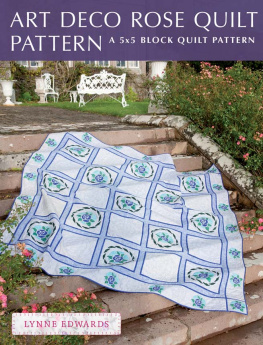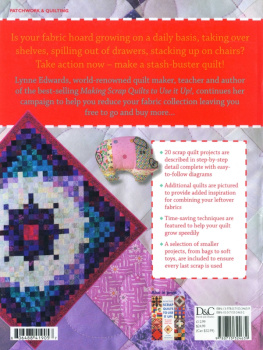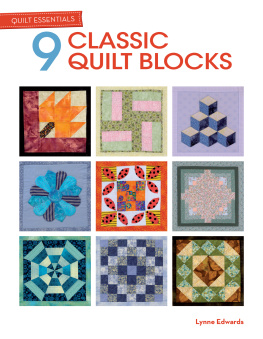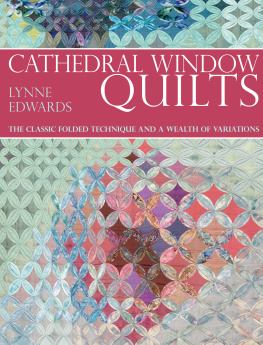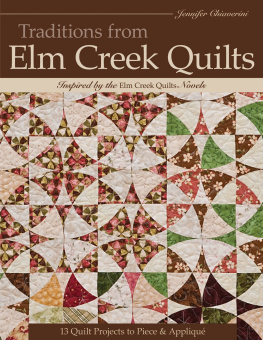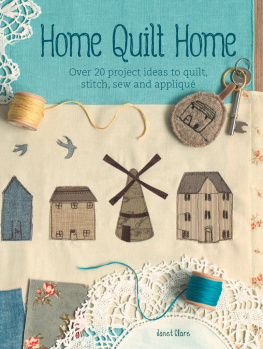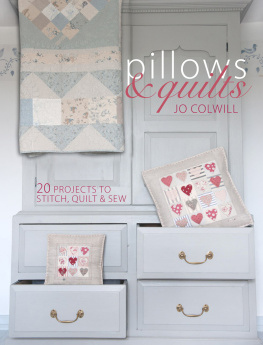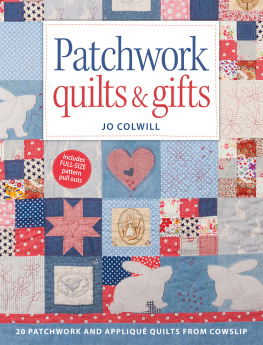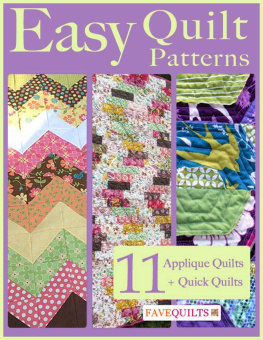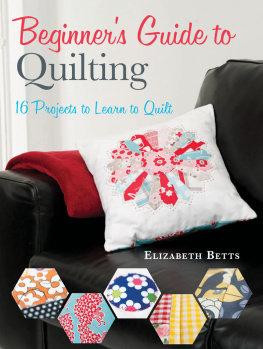This section describes the essential techniques you will need to create the blanket stitch appliqu for this project. More general techniques required for quilt making, such as adding borders, quilting and binding are described in General Techniques.
Most of the appliqu patterns are printed full size as they appear in the quilt, although some will need to be enlarged. These patterns are used as a reference when arranging the separate pieces of fabric to build up the final appliqu design.
When using the stick-and-stitch technique, the appliqu shapes must first be reversed. The design is then separated into the various shapes that make up the final image. Any shape that is overlapped by another will need an extra amount added, about in (3mm) wide to the edge that will be overlapped. This is shown as a dashed line on the separate shapes and should be included when the shapes are traced on to the paper side of the fusible web. For each of the designs in the book, all the reversed pieces are shown labelled and grouped ready for tracing.
TIP
With this technique most of the inner section of the fusible is removed before the outline is ironed on to the fabric. If this inner area is large enough, I have placed one or more smaller outlines within it to be traced as positioned. Once that area of web has been cut and removed from the large drawn outline, the smaller shapes marked on it can then be cut out as usual.
USING FUSIBLE WEB
Place the fusible web smooth side uppermost over the reversed shapes of the design as given in each project. Trace each section including any dashed areas. Mark the grain line arrows and the numbers on the tracing, keeping these at the very edge of the shape rather than in the centre, as the centre area of fusible web will be removed later. The shapes can be traced closer together but leave about in (1.3cm) between each traced shape to make cutting out easier. Cut out each traced shape roughly in (6mm) beyond the outer drawn line (see Photo below).

Carefully cut out the central area of fusible web and remove it, leaving only about in (3mm) inside the drawn line. The removed pieces of fusible can be kept for later projects. If the removed area has extra, smaller shapes traced on to it, these can now be cut out in the same way. Dont try to cut away the inner areas of any small or narrow pieces less than 1in (2.5cm) across as they are just too fiddly.


Place each cut piece of fusible web rough side downwards on the wrong side of the fabric, matching the grain line arrow with the grain or weave of the fabric. Press with a hot iron to stick the web to the fabric.
Now cut accurately along the drawn line through both the paper and the fabric. Include in the cut-out shape any dashed area.

The numbers on the reverse of each piece tell you the order in which to build up the design. If the design is very simple, it can be built up directly on the background fabric, using the drawing of the finished design as a guide for positioning each piece. Take the first piece, remove the paper backing and position the piece right side up, glue side down on the background. Add each fabric shape in turn until the design is complete. Dashed areas need to be overlapped by other pieces. When you are happy with the arrangement, press everything with a hot iron to fix the pieces in place.
For a more complex design where you need to be very accurate with the positioning of each fabric shape, use an appliqu pressing sheet or non-stick baking parchment paper to help. Lay the pressing sheet or paper over the drawn design you will be able to see the design through the plastic sheet. The non-stick baking parchment paper is less transparent, but should still allow the design to show through well enough for positioning the pieces on to it. The whole design is assembled piece by piece and ironed on to the pressing sheet or parchment paper (see Tip below). Once it is complete, only then will it be carefully peeled away from the background plastic or paper and re-positioned and ironed in place on the background fabric.
TIP
Fix the design and parchment paper or pressing sheet on to the ironing surface with pins or masking tape at the corners to keep everything in position as you stick.
Blanket Stitching by Hand
These guidelines for stitching the design by hand are for right-handed quilters. Left-handers need to study the photographs in a mirror to follow the step-by-step instructions. Start at the end of a piece of fabric, preferably where it is overlapped by another appliqu piece. Once you are more experienced, it can be your choice where you begin and finish, but this makes for an easier and less obvious starting point.
Turn the work so that the appliqu fabric is to the right and the background fabric is to the left. Keep the edge of the appliqu running straight towards you at all times at the point where you are stitching.

Make a knot at the end of the thread. Begin by bringing the needle up from the back in the background fabric close to the edge of the appliqu.

Make one stitch at right angles to the edge of the appliqu and bring the needle back up in the same place as the thread. The needle should be horizontal when making this stitch. The stitch length is your choice. I like to make a stitch a generous in (3mm) with spacing between about half this. Dont worry too much become comfortable with the stitching action and as you find a stitching rhythm your hand will settle into the spacing and size of stitch that it likes best.

Pull the thread across to the left to tighten the stitch.

Hold the thread flat with your thumb. Bring the needle back to the appliqu, making a thread loop.


